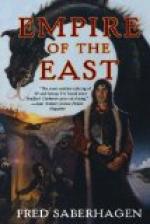Ostrog is about six hours’ drive from Podgorica. The road passes along the River Zeta, leaving the village of Spuz on the right, and past the flourishing little town of Danilovgrad, soon to be the connecting town between Cetinje and Niksic on completion of the projected road.
There is nothing of interest in Danilovgrad, though the market is of some importance. A little way beyond the town a nearly complete building can be noticed. It is the lunatic asylum.
From this point onwards the road ascends slowly but steadily until a deep valley lies to the right, and the Zeta assumes quite diminutive proportions. The mountains opposite rise to an ever-increasing height, until a few tiny buildings can be made out by the help of field-glasses. It is Ostrog. That morning we could make out the tents and booths of the pilgrims, and a dark mass of surging humanity. But it is still a very long distance away. The road climbs up to the head of the valley to the village of Bogetic, full that morning of the carriages of the wealthy pilgrims. During the Whitsun festival carriages are scarcely to be procured in the whole of Montenegro, or in Cattaro either.
We broke our fast here, and then drove for another mile or so where a path leaves the road, and the pilgrim has either to proceed on horseback or on foot. We had to go on foot, and a very long and tiring walk it proved to be. Besides Dr. S. and his factotum, Lazo, we took another man with us, a wretched puny individual, but seemingly possessed of more endurance than any of us. He led us by a short cut over rocks, and up slippery breakneck walls of cliffs, over which our guide skipped nimbly, and having reached the top seemingly hours before us, sat down and beamed benevolently.
Half-way, the rain came down in sheets, and we took shelter in a wayside inn, or rather hut. It was crowded with returning pilgrims whom the threatening weather had forced to depart earlier than is their wont.
As the weather momentarily cleared, we pushed on, and the remaining distance was one of the most interesting walks it had been our fortune to witness. A ceaseless stream of pilgrims poured down the rocky path. It came on to rain again, but one and all wished us luck in the name of God and S. Vasili. Nearly every costume of the Balkans was represented. The Bosnian, in sack-shaped baggy trousers, fitting the lower leg, either of crimson or blue cloth, a smart-coloured Turkish jacket, a broad shawl round his waist displaying armouries of knives and pistols, on his head a fez wound round with a huge turban cloth, mounted, or leading a pack-horse; his wife in coarse black trousers; the Hercegovinans, with breastplates of silver ornaments, exquisite in workmanship and of great antiquity; sombre Servians, and white-clad Albanians, whose trousers are embroidered with black braid in fantastic tracing; fez, head-cloth, and neat little Montenegrin cap; trousers of red, pink, blue and black; gigantic Albanians in high riding-boots, sitting their horses like Life Guardsmen; Macedonians, Greeks, and even pure-blooded Turks; Montenegrins in creamy white frock-coats worn over gold-braided crimson jackets; and dark-blue costumes with red worsted tassels of the poor Dalmatian peasants—all passed us in bewildering confusion.




